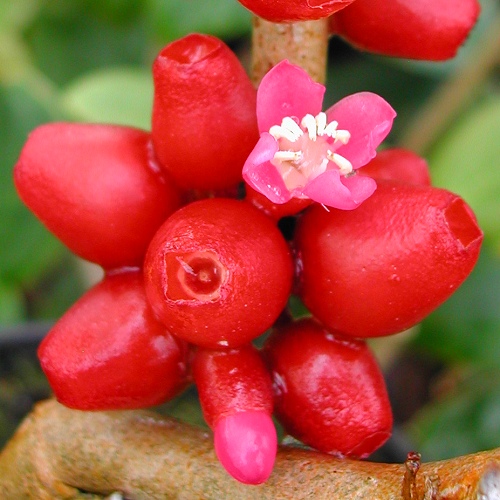Germinating the seeds
When to plant - Plant them when you receive them for best results. Pot size - Use small pots, or cups with drainage holes, about 1.5 to 3 inches (4-7 cm) tall and wide. Soil --
Use well-draining soil. I use a mix of 1
part
coir fiber Fill the pots with soil and
place a seed or 2 on the surface.
If you have
long-fibered sphagnum moss Until the seeds sprout, ensure that the surface soil always stays moist. A plastic dome or bag may be used to maintain moisture, but leave it open slightly to allow some fresh air in. You may need to drip a few drops of water over the seeds every day to keep the seeds moist. Aim to keep the seeds between 65 and 80° F (18-27°C). I have no information about how well they germinate outside that temperature range. I recommend placing a minimum/maximum thermometer near the pots. Place the containers in a bright spot out of direct sun. An LED or fluorescent bulb kept 4 inches (10 cm) away provides the right amount of light (See: "Growing indoors with LED lights"). They tend to begin sprouting within about 6 weeks, but may take a little longer. The seedlings are small when they sprout, and they grow slowly, so they require close monitoring the first few 2-3 months, to ensure they are not neglected. Lighting -- After they sprout, continue keeping them in a bright spot, with protection from afternoon sun. Watering: After the seedlings are 5 weeks old, you may allow the soil surface to dry out between waterings, but aim to keep the rest of the soil evenly moist most of the time. Never let it dry out completely, but also avoid keeping it constantly soggy. If your water supply is very high in minerals (= "hard water"), it's best to use bottled water or rainwater. Fertilizing -- The first 3 months, feed weekly with a small amount of dilute (1/8 strength) liquid fertilizer. Hydroponic fertilizer is ideal for seedlings, because it is easily absorbed and contains all essential nutrients. After 3 months, you may switch to a granular fertilizer that contains micronutrients, feeding at half the dosage on the package. Or continue feeding weekly with dilute liquid fertilizer Climate -- The plant will probably need to be grown indoors, except in Zones 10 or above. Ideal temperatures seem to be between 55 and 85 degrees F (13-29°C). I have no information how it will do outside that temperature range. Since it comes from forests, it enjoys filtered sunlight. Adult plants can handle some sun, but may need some shade from strong afternoon sun. Over about 50% humidity is best. Repotting -- Once your seedlings are at least 1.5 inches tall (4 cm), you may repot them to larger containers. Repot gently to avoid damaging the root hairs. Repot into a porous mix, such as half potting soil and half fine-grade orchid bark (or perlite). For the first week or two after repotting, shade from sun and give no fertilizer. Insects to watch for -- Look for any insects that you find on your other houseplants. Aphids, mealy bugs, and spider mites might attack them, but insecticidal soap spray can control them. Happy growing! - Jeff Strange Wonderful Things
|
|||||||||


